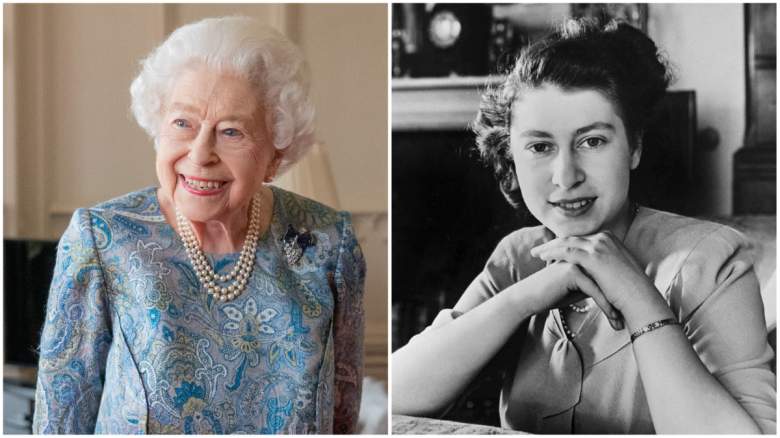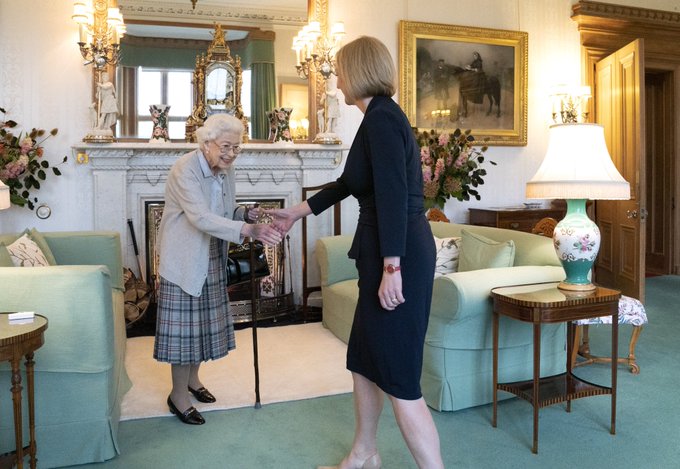
Getty Queen Elizabeth's health is a growing concern.
Queen Elizabeth II died Thursday, September 8, 2022. Born on April 21, 1926, she was 96 years old at the time of her death. Although an exact cause of death has not been officially shared, she had recently been under medical observation and “died peacefully,” The Royal Family announced.
Here’s what you need to know:
The Royal Family Was Gathering Out of Concern for Her Health
On Thursday, September 8, Buckingham Palace announced that doctors were concerned about the Queen, as her health had been deteriorating, the New York Times reported.
“Following further evaluation this morning, the queen’s doctors are concerned for Her Majesty’s health and have recommended that she remain under medical supervision,” the palace shared in a statement.
Just hours later, The Royal Family shared in a statement, “The Queen died peacefully at Balmoral this afternoon.”
The statement continued: “The King and The Queen Consort will remain at Balmoral this evening and will return to London tomorrow.”
The news came after the Queen canceled a virtual meeting on Wednesday in order to rest, The New York Times reported. She had canceled several public appearances in recent years, although she did meet the new prime minister in a public appearance on September 6.
The Royal Family gathered to be with the Queen. Prince Charles — now referred to by Buckingham Palace as His Majesty The King — and his wife, Camilla, now The Queen Consort, were among the first at Balmoral Castle, the New York Times reported, along with the Queen’s daughter Princess Anne. Prince William, second in line to the throne, was traveling to Scotland to join the family, as were her other sons Prince Andrew and Prince Edward.
Prince Harry and Meghan, the duchess of Sussex, also headed to Balmoral Castle, The Hill reported. Wiliam’s wife Kate, the duchess of Cambridge, was staying in England for their children’s first day of school, the outlet reported citing the United Kingdom’s PA Media.
The Queen Had COVID-19 in February & Other Recent Health Issues
On February 22, 2022, People reported that Queen Elizabeth II had canceled some virtual meetings due to experiencing mild COVID-19 symptoms.
According to the outlet, Buckingham Palace said in a statement at the time: “As Her Majesty is still experiencing mild cold-like symptoms she has decided not to undertake her planned virtual engagements today, but will continue with light duties.”
Several other members of the Royal household also tested positive at that time. Her diagnosis was first announced on Sunday, February 20, when Buckingham Palace said in a statement: “The Queen has today tested positive for Covid. Her Majesty is experiencing mild cold-like symptoms but expects to continue light duties at Windsor over the coming week… She will continue to receive medical attention and will follow all the appropriate guidelines.”
In May 2022, a source told Us Weekly that the Queen had been advised to “go a lot easier on herself, even if it means missing more functions than she would like.” They noted that her attendance at events was being decided “on a case-by-case basis” and she would turn over her duties any time she wasn’t “100 percent.” They noted that she was adjusting but had “more energy” due to not overexerting herself.
Then in June 2022, she missed some Platinum Jubilee festivities because of health issues, Us Magazine reported. A source told Us Weekly that she was “sharp as a whip” but had “episodic mobility” issues.
In October 2021, Queen Elizabeth II was hospitalized overnight and canceled a visit to Northern Ireland, Us Magazine reported. In November 2021, Prince Charles told a reporter while on royal tour in Jordan, “Once you get to 95, it’s not quite as easy as it used to be. … It’s bad enough at 73.”
She Ruled Longer Than Any Previous British Monarch
According to her Buckingham Palace biography, “The Queen has ruled for longer than any other Monarch in British history.” She also traveled more than any other monarch, her biography noted, and she was known for her “sense of duty and devotion to a life of service.”
She worked with more than 600 charities, military organizations and public service organizations, according to the biography.
The queen was the Head of State, Buckingham Palace’s website explains, and although she had no political or executive role, she still had many constitutional duties dating back more than 1,000 years.
The website noted: “The Sovereign acts as a focus for national identity, unity and pride; gives a sense of stability and continuity; officially recognises success and excellence; and supports the ideal of voluntary service.”
While Queen Elizabeth II was originally third in line to the throne, according to her biography, she became first in line after King Edward VIII gave up the throne to marry the woman he loved, leading to her father becoming king. When King George VI died on February 6, 1952, after a long illness, she became queen.
Her coronation took place on June 2, 1953.
Her Husband, Prince Philip, Died on April 9, 2021
Queen Elizabeth’s husband, Prince Philip, died at the age of 99 on April 9, 2021. Buckingham Palace shared at the time that he had died peacefully at Windsor Castle. He had been hospitalized several times due to health issues in the years prior to his death.
Queen Elizabeth described Prince Philip as her “strength and stay,” Time reported.
Prince Philip and then-Princess Elizabeth were married in 1947. She became queen five years later and had four children, eight grandchildren and 10 great-grandchildren. Prince Charles — heir to the throne and Prince of Wales — was born in 1948. Princess Anne, the Princess Royal, was born in 1950. Prince Andrew, Duke of York, was born in 1960. Prince Edward, Earl of Wessex, was born in 1964.
READ NEXT: Queen Elizabeth II’s Successor: Who Is Next in Line for the British Throne?

